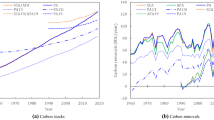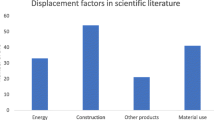Abstract
With the analytical tool: Frankfurt Harvested Wood Products (HWP) Model, carbon stocks and carbon stock changes of HWP, either in USE or in LANDFILLS, have been evaluated from the readily available statistical data base of the FAO, FAOSTAT, on the wood commodities: “Sawnwood and Wood-based Panels” and the paper commodities: “Paper and Paperboard”. Essential differences have been found between the individual 15 EU countries in the comparison of the Stock Change Approach and the Production Approach, as well as in the comparison of the stock changes of HWP with the National Greenhouse Gas (GHG) budgets. The stock changes for the HWP in USE within the EU-15 Community have been calculated to be 10.83 Mt C/a (39.71 Mt CO2/a) based on the Stock Change Approach and 9.81 Mt C/a (35.97 Mt CO2/a) for the Production Approach, respectively. These numbers can be compared to the total GHG Inventory of the EU-15 of 4,095 Mt CO2 equivalents, including all six Kyoto gases, which shows that the carbon sequestration of HWP in USE is of the order of 1% relative to GHG Inventory. The GHG balance for the carbon stock changes of HWP in LANDFILLS is of similar magnitude as for the HWP in USE, and therefore a sink when methane outgasing is disregarded. However, when methane outgasing is considered, which is formed as a 1:1 mixture with CO2 under the prevailing anaerobic conditions the GHG balance results in minus 10.0 Mt C equivalent/a and minus 10.6 Mt C equivalent/a for the Stock Change Approach and the Production Approach under the parameters chosen in this study.

Similar content being viewed by others
References
Austropapier (2004) Vereinigung der Österreichischen Papierindustrie, Das Jahr 2004 in Zahlen. http://www.austropapier.at/statistik_frame.htm
Burschel P, Kürsten E, Larson BC (1993) Die Rolle von Wald und Forstwirtschaft im Kohlenstoffhaushalt—Eine Betrachtung für die Bundesrepublik Deutschland. Ludwig Maximilian-Universität München, Forstwissenschaftliche Fakultät, Munich, 135 pp
Eggers T (2002) The impacts of manufacturing and utilization of wood products on the European carbon budget, Internal report no. 9, European Forestry Institute (EFI)
EU Council Directive 1999/31/EC (1999) On the landfill of waste. Official J Eur Commun L182/1-L182/19, 16.7.1999
FAO State of the World’s Forests (2003) FAO Forestry Department, Rome
FAOSTAT Data Base Collection (2004) (i) Roundwood, sawnwood, wood-based panels and (ii) Paper&Paper Board. Internet http://www.faostat.fao.org/faostat/collections?version=ext&hasbulk=0&subset=forestry
Ford-Robertson J, Duignan A (2001) Summary of the harvested wood products workshop; Rotorua, New Zealand, February 2001. http://www.joanneum.ac.at/iea-bioenergy-task38/workshops/canberra01/fordrobertson.ppt#258,2
Glaser WG, Northey RA, Schultz (eds) (2000) Lignin—historical, biological and materials perspectives. Oxford University Press, Oxford, 576 pp; see also Northey RA http://www.cfr.washington.edu/classes.cfr.101f/Northey-paper.pdf
Heath LS, Kauppi PE, Burschel P, Gregor HD, Guderian R, Kohlmaier GH, Lorenz S, Overdieck D, Scholz F, Thomasius H, Weber M (1993) Contribution of temperate forests to the world’s carbon budget. Water Air Soil Pollut 70(1–4):55–69
Intergovernmental Panel on Climate Change IPCC: Third Assessment Report TAR. Climate Change (2001) In: Houghton JT et al (eds) The scientific basis. Cambridge University Press, Cambridge
Karjalainen T, Kellomäki S, Pussinen A (1994) Role of wood-based products in absorbing atmospheric carbon. Silva Fenn 28(2):67–80
Kohlmaier GH, Badeck FW, Otto RD, Häger Ch, Dönges S, Kindermann J, Würth G, Lang T, Jäkel U, Nadler A, Klaudius A, Ramge P, Habermehl S, Lüdeke MKB (1997) The Frankfurt biosphere model. A global process oriented model for the seasonal and long-term CO2 exchange between terrestrial ecosystems and the atmosphere. II: Global results for potential vegetation in an assumed equilibrium state. Clim Res 8:61–87
Kohlmaier GH, Weber M, Houghton RA (eds) (1998) Carbon dioxide mitigation in Forestry and Wood Industry. In: Proceedings of the Freising workshop, 1996. Springer, Berlin Heidelberg New York, 375 pp. ISBN 3-540-63433-9
Kohlmaier GH, Schefold B, Rohner M, Spitzer J (1999, update 2004) Wood energy in the industrialized world: present status and potential contribution to CO2 mitigation. Technology, economy and policy issues. In: International workshop Graz, Austria 19–20 November 1999, update May 2004 (CD available from G. Kohlmaier)
Pingoud K (2002) Software tool: calculation procedures of stock and stock changes of harvested wood products HWP in BioEnergy-Task 38, Joanneum, Graz. http://www.joanneum.ac.at/iea-bioenergy-task38/
Pingoud K, Savolainen L, Seppälä H (1996) Greenhouse impact of the Finnish forest sector including forest products and waste management. Ambio 25(5):318–326
Pingoud K, Perälä A, Pussinen A (1999) Inventorying and modeling of carbon dynamics in wood products. In: Robertson KA, Schlamadinger B (eds) Bioenergy for mitigation of CO2 emissions: the power, transportation and industrial sectors. Proceedings of the IEA Bioenergy Task 25 workshop, Gatlinburg. IEA, Graz pp 125–140
Pingoud K, Schlamadinger B, Grönkvist S, Brown S, Cowie A, Marland G (2004) Approaches for inclusion of harvested wood products in future GHG inventories under the UNFCCC, and their consistency with the overall UNFCCC inventory reporting framework. IEA BioEnergy, Task 38, Joanneum, Graz. Greenhouse gas balances of biomass and bioenergy systems 13
Scharai-Rad M, Welling J (1999) Biomass for greenhouse gas emission reduction: sawn timber and wood based products as building materials. Working Report Nr. 1999/01 Institut für Holzphysik und mechanische Technologie des Holzes. Bundesforschungsanstalt für Forst- und Holzwirtschaft, Germany
Skog KE, Pingoud K, Smith JE (2004) A method countries can use to estimate changes in carbon stored in harvested wood products and the uncertainty of such estimates. Environ Manage 33:(Suppl. 1)
Spieker H, Mielikäinen K, Köhl M, Skowsgaard J-P (eds) (1996) Growth trends in European forests—studies from 12 countries, European Forest Research Institute. Report No. 5. Springer, Berlin Heidelberg New York, 372 pp
Umweltbundesamt UBA (2003) German GHG Inventory 1990–2001, National Report. www.umweltbundesamt.org/fpdf-l/2515.pdf
Umweltbundesamt UBA (2004) German GHG Inventory 1990–2002, National Report. GHG Inventory 1990–2002, published in 2004
UN (1992) United Nations Framework Convention on Climate Change (UNFCCC). United Nations, New York/Geneva, 33 p
UN (1997) Kyoto Protocol to the Unites Nations Framework Convention on Climate Change. United Nations, New York/Geneva, 23 p
UN-ECE, United Nations Economic Commission of Europe, Main Report, Geneva (2000) Timber and Forest Study Papers, No. 17. Forest Resources of Europe, CIS, (Commonwealth of Independent States), North America, Australia and New Zealand—Industrialized temperate and boreal Industrialized States; originally called: Temperate and Boreal Forest Resources Assessment, 2000, TBFRA-2000. http://www.unece.org/trade/timber/fra/welcome.htm
Winjum JK, Brown S, Schlamadinger B (1998) Forest harvests and wood products: sources and sinks of atmospheric carbon dioxide. For Sci 44(2):272–284
Acknowledgments
The selected data base (FAOSTAT) and EXCEL spreadsheets on HWP of Dr Kim Pingoud, Finland have been greatly appreciated. Advice from Dr Bernhard Schlamadinger; Austria with respect to the Kyoto Protocol and the UNFCCC is thankfully acknowledged. The paper is dedicated to all scientists and policy makers who in the end succeeded that the Kyoto Protocol could go into force on February 16, 2005.
Author information
Authors and Affiliations
Corresponding author
Additional information
Communicated by Walter Warkotsch
Presented in Dublin, October 6–9, 2004, COST-21 Plenary Session.
Appendix
Appendix
Four country comparison between the analytical and the numerical calculations for the stock change approach.
Table 7 refers to the calculations for the countries: Austria, Finland, Germany, Portugal and the EU-15 which have been studied in particular depth. It shows that the agreement between the two calculation methods is excellent, except for the calculated annual carbon change of the HWP in USE. Columns B–D are input data of the calculations, with reference to the year 2000. The analytical approach uses exponentially smoothed data, which are different from the annual input data of the numerical method. Columns E–K are results of the calculations: The ultra-simple calculation procedure of the analytical approach is given in the column heading, as described in the paper above. The numerical calculation procedure is the stepwise Euler integration either in the explicit form, called forward integration or in the implicit form, called backward integration. Starting with the integration of the differential equation of the form:
as described previously by Pingoud (2002), where x(t i ) stands for stock of HWP either in USE or in LANDFILLS at time t i and where F in(t i ) stands for HWP production (or consumption) or waste production in the year t i .
Forward integration, with time step 1 year: t 2 − t 1 = 1, yields
while backward integration, which is preferred here, leads to:
It can be seen from column E that the agreement between the two approaches is within 1% for the HWP stocks of sawnwood and wood-based panels. The cumulative procedure in determining the stock in the numerical method shows that nearly any differences between the two methods are wiped out. The stock changes for the year 2000, shown in column F, are in contrast, quite different for the two methods, and can differ by as much as 50% (see Finland).
However, when the numerical annual changes are plotted as a function of time and smoothed and fitted to an exponential function, a posteriori, the results of the analytical method can be reproduced. Columns G–I give the HWP stocks in LANDFILLS, for two cases. Case 1: the stocks are already in a stationary state in the year 1900 (column G) or case 2: The stocks are 0 in 1900 (I); the difference between the two cases is given column H. The stocks calculated by the two methods do not differ by more than 2%. Column J gives the annual change in landfills, which is here much less different for the two approaches as the stocks have been smoothed through the inputs which depend on the stocks of the HWP in USE. Similar considerations are valid for GHG balance with methane outgasing, except that the calculated difference between two small numbers can result in seemingly larger differences between the two methods. The last row shows the agreement with the calculations of Pingoud (2002) for Austria, which were obtained under slightly differently chosen parameters.
Rights and permissions
About this article
Cite this article
Kohlmaier, G., Kohlmaier, L., Fries, E. et al. Application of the stock change and the production approach to Harvested Wood Products in the EU-15 countries: a comparative analysis. Eur J Forest Res 126, 209–223 (2007). https://doi.org/10.1007/s10342-006-0130-x
Received:
Accepted:
Published:
Issue Date:
DOI: https://doi.org/10.1007/s10342-006-0130-x




